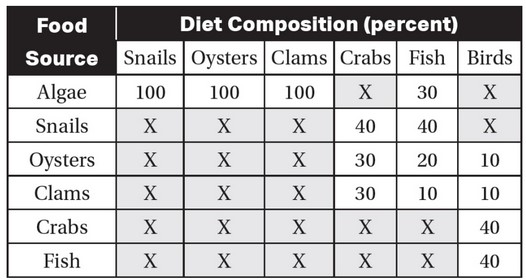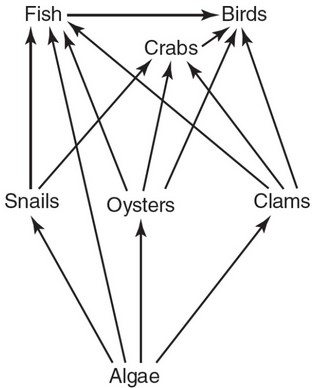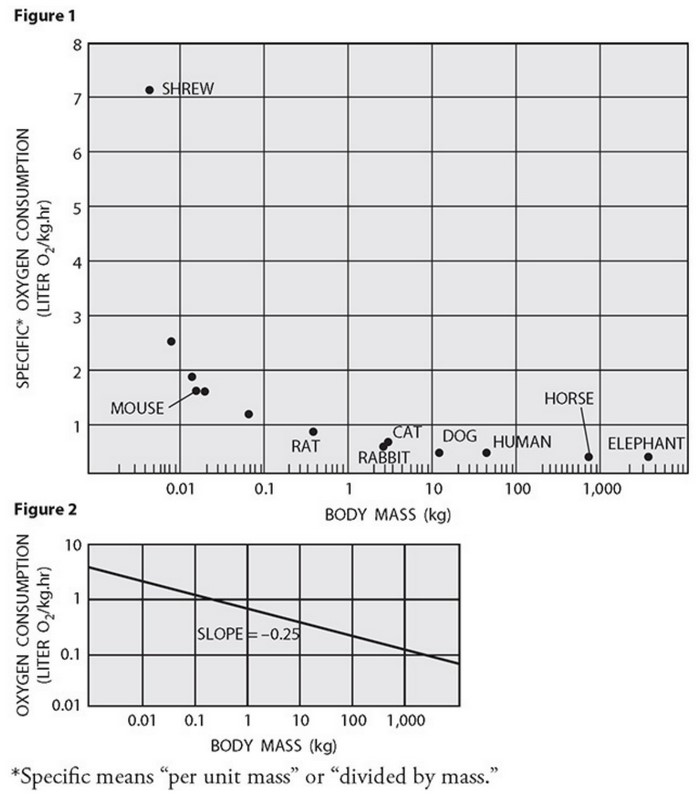Question
The following table shows the diet composition of members of an estuarine ecosystem (a shallow, coastal shelf where a freshwater river
empties into a larger saltwater body). Higher percentages indicate a higher degree of reliance on a particular food source. An “X” indicates that the source is not a food source for that organism.

(a) Describe the role of algae in this ecosystem.
(b) Represent the relationships between these organisms by constructing a food web for this ecosystem.
(c) Identify the secondary consumers in this ecosystem.
(d) Predict the organism in this ecosystem that will have the lowest biomass. Explain why you made this prediction.
▶️Answer/Explanation
Ans:
(a) Algae are producers and are the only member of this ecosystem that
can perform photosynthesis. Therefore, algae either directly or
indirectly provide organic compounds to the other members of this
ecosystem.
(b) 
(c) Secondary consumers eat primary consumers. Primary consumers
eat producers. The primary consumers are snails, oysters, clams, and fish. Therefore, the secondary consumers are crabs, fish, and
birds.
(d) Birds should have the fewest numbers since they are a top predator.
Question

Choose two of the communities represented in the table above and explain why they differ in the number of trophic levels they can support.
▶️Answer/Explanation
Ans:
Two significant determinants of the number of trophic levels an
ecosystem can support are the net primary production and ecological
efficiency. The coastal marine ecosystem and the tropical forest ecosystem
both have the same net primary production (8,000 kcal/m2
/year), but the
ecological efficiency of the open ocean ecosystem (20%) is much greater
than the tropical rainforest ecosystem (5%). The ecological efficiency is a
measure of how much energy is transferred from one trophic level to
the next. The greater the efficiency, the greater the number of trophic levels
that can be supported for a given rate of net primary production.
Question

Smaller mammals tend to have shorter life spans than larger mammals.
Choose one physiological reason that could account for the shorter life span and explain how it could affect an organism’s life span.
▶️Answer/Explanation
Ans:
Small body size in mammals imposes several physiological
challenges:
• Temperature regulation: smaller mammals have a higher surface-
area-to-volume ratio, increasing heat losses and creating greater energy demands to maintain body temperature.
• In small mammals, the energy and oxygen requirements are quite
large relative to body size, creating greater energy demands.
• The higher oxygen consumption of smaller mammals requires
greater blood flow. For example, 1 gram of shrew tissue consumes
100 times as much oxygen as 1 gram of elephant tissue, which
requires 100 times greater blood flow in the shrew compared with
the elephant.
